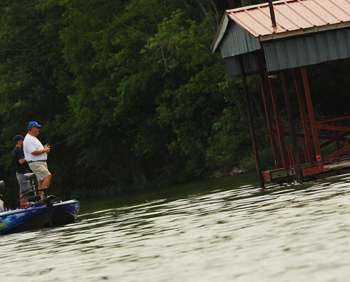
Spring’s arrival brings slugfest potential, although stepping from the cold season to the warm often requires some fancy footwork. For this awkward transitional time, Elite Series pro Mark Davis brings a one-two combination that gives him what he needs to win each round — often with a knockout. One of his tactics floats like a butterfly and stings like a bee, while the other just pounds it out in a George Foreman kind of way. Before we give you the game plan, let’s talk perspective.
“You have fish trying to move up and they have spawning on their minds, but every third day you have some kind of weather — cold, rainy — that holds them back,” said the Mount Ida, Ark., angler. “So you have what I call ‘the yo-yo effect’ where the fish come up, then move back, then come up again. You do have some fish that come up and stay, but they get really hard to catch.”
Noting the importance of sustained warmth and barometric stability to the prespawn movement, Davis said the stubborn conditions of early 2010 slowed the already creeping seasonal progression. However, he always looks for the silver lining.
“The good news is that when you have a prolonged winter like we’re having, the fish are in a holding pattern,” Davis said. “They’re ready to make their move, and when it does finally happen, it all happens at once and it’s off-the-charts good. The fish are just bursting with eggs and they’ll run to the bank and feed like crazy.”
Anticipating the eruption, but mentally prepared for a couple more weeks of patient searching, Davis approaches the changeover with two main offerings: a crankbait and a football head jig. The former enables him to chase down a squirrely opponent, while the latter brings the heavy leather once he gets ’em on the ropes.
“When fishing gets tough and the bite slows down, you can cover the area thoroughly with the crankbait,” Davis said. “Once you have confidence in the area, you can take that jig and pick it apart.”
On his home waters of Lake Ouachita, or on the TVA lakes he favors, Davis will use a Strike King Series 5 crankbait for the 10- to 13-foot range. In shallow lakes, a Strike King Redeye Shad gets the call. He likes the red, brown and orange tones of crawfish patterns, but in stained water, he ties on a chartreuse bait with a brown back.
Davis cranks with a 7-foot All Star cranking rod and a 5:1 Pflueger Trion reel loaded with 14-pound Stren monofilament. Testing different retrieves is key, and Davis said he’s a fan of sensitivity.
“Once you locate the cover, stop moving the bait with your reel and use your rod to sweep the bait through the cover,” he suggests. “You’ll be surprised at how much ‘feel’ you’ll gain. That will help you a lot. You’re gaining a lot of control, but you’re also slowing down, and that’s important to catching (early spring) fish. You can slow the bait down, crawl it and just finesse it.”
When cranks locate fish, or if fish turn cranky, Davis grabs a 1/2- to 3/4-ounce Strike King football head jig with a Strike King Rage Tail Craw trailer — all in green pumpkin. He fishes his jig on a 7-foot medium-heavy All-Star ARS Series rod with 6.4:1 Pflueger Patriarch reel carrying 15-pound Stren fluorocarbon. Bumping bottom with a little crustacean impersonation is the deal here.
“It looks a lot like a crawfish. It’s the same thing that we’ve done with Carolina rigs for years,” Davis said. “You’re not hopping it — you’re just keeping contact with the bottom. You’re going to hit some cover or some stumps, and you’ll have to work it through there. The football head jig is not made for heavy cover, but for sparse cover it works great.”
Until spring officially settles, Davis advises sticking with deep water adjacent to a lake’s primary spawning areas.
“That will be relative to the body of water you’re fishing, but don’t get too far away from the deep water until this weather breaks and you’ll be all right.”





